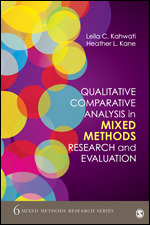Qualitative Comparative Analysis in Mixed Methods Research and Evaluation
- Leila C. Kahwati - RTI International
- Heather L. Kane - RTI International
Mixed Methods Research Series
Qualitative Comparative Analysis in Mixed Methods Research and Evaluation provides a user-friendly introduction for using Qualitative Comparative Analysis (QCA) as part of a mixed methods approach to research and evaluation. Offering practical, in-depth, and applied guidance for this unique analytic technique that is not provided in any current mixed methods textbook, the chapters of this guide skillfully build upon one another to walk researchers through the steps of QCA in logical order. To enhance and further reinforce learning, authors Leila C. Kahwati and Heather L. Kane provide supportive learning objectives, summaries, and exercises, as well as author-created datasets for use in R via the companion site.
Qualitative Comparative Analysis in Mixed Methods Research and Evaluation is Volume 6 in SAGE’s Mixed Methods Research Series. To learn more about each text in the series, please visit sagepub.com/mmrs.
Supplements
“This book is written in a way that is easy to follow and should expand the range of fields in which QCA is used. Also, there are quite a few principles and practice tips articulated, especially in later chapters, which are applicable more broadly across social sciences and evaluation work. Novice researchers will find those suggestions especially helpful, even if QCA does not become a major tool in their practice.”
“The practical, how-to, nature of the text is very appealing to me as an instructor. I like the examples and appreciate the numerous figures used to illustrate processes and arguments for visual learners.”
“The text introduces an important, specific approach to research.”
“I think the key strengths of this text are its organization and breadth. From an organization perspective, the wealth of resources and focus is essential for guiding the reader/learner toward practical keywords, i.e. language, and skills necessary to implement.”
This is a very good resource for students and teaching

